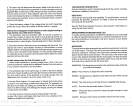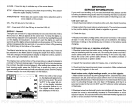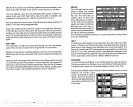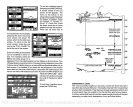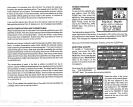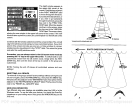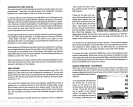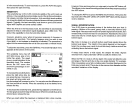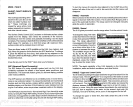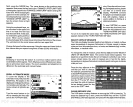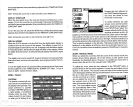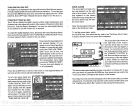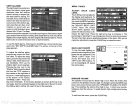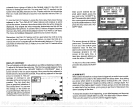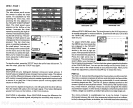
MENU
-
PAGE 5
____________________________
To turn the
menus
off,
press
the
key
adjacent
to the CLEAR
key
at the
ADJUST CHART SURFACE
CLARITY
The
markings
extending
down-
ward
from the zero line on the
chart are called "surface clut-
ter." These
markings
are
caused
by
wave
action,
boat
wakes,
temperature
inversion,
and other natural causes.
The Surface
Clarity
Control
(5CC)
reduces
or eliminates surface clutter
signals
from the
display.
3CC varies the
sensitivity
of the
receiver,
decreasing
it near the surface and
gradually increasing
it as the
depth
increases. The maximum
depth
that 5CC will affect is 75% of the selected
depth
range.
For
example,
on a 0-60 foot
range
with maximum
8CC,
surface
clutter will be reduced down to 45 feet.
There are
three levels of 8CC available on the X-55:
low, medium,
and
high.
When it's turned
on forthe first
time,
the 8CC level is low. To
change
it,
press
the
MENU
key
five
times,
then
press
the
key adjacent
to the
"ADJUST CHARTSURFACE CLARITY"
label until the black box is on the
desired 3CC level.
Press the
key
next to the "EXIT" label when
you're
finished.
ASP
(Advanced Signal Processing)
The ASP feature is a noise
rejection system
built into
the X-55 that
constantly
evaluates the effects of boat
speed,
water
conditions,
and
interference. This automatic feature
gives you
the best
display possible
under most conditions.
The ASP feature is an effective tool in
combating
noise. In
sonar
terms,
noise is
any
undesired
signal.
It is caused
by
electrical
and mechanical
sources
such as
bilge pumps, engine ignition systems
and
wiring,
air
bubbles
passing
over the face of the
transducer,
even vibration from
the
engine.
In all
cases,
noise
can
produce
unwanted marks
on the
display.
The ASP feature hastwo
levels
-
Normal and
High.
If
you
have
high
noise
levels,try using
the
"Nigh"
ASP
setting.
However,
if
you
are
having
trouble
with
noise,
we
suggest
that
you
take
steps
to find the interference
source
and fix
it,
rather than
continually using
the unit with the
high
ASP
setting.
bottom left side of the unit
or wait a few seconds and the menus will
disappear.
RANGE
-
Automatic
When turned
onforthefirsttime, theX-S5automatically placesthe
bottom
signal
in the lower half of the screen. This
is called Auto
Ranging
and is
part
of the automatic function. The
range
cannot be
changed manually
while the unit is in automatic.
RANGE
-
Manual
The X-55
gives you
control overthe
range
when it's in the manual
mode.
To
change
the
range,
first make
_____________________
certaintheX-55
isinthe manual
mode.
Next,
pressthe
RANGE
key.
The
range adjustment
menu
appearsinthe
lower
right
cornerof the
display.
Pressthe
up
or down
arrow
keys
to de-
crease or increase the
range.
_____
The available
range.s
are
0-5,
___________
10, 20, 30, 40, 60, 100, 150,
200, 300, 500, 800,
and 1000
________________
feet. After the desired
range
is
displayed, press
the CLEAR
key
to erase the
range
menu.
NOTE: The
depth capability
of the X-55
depends
on the transducer
installation,
water and bottom
conditions,
and other
factors.
RANGE
-
Upper
and Lower Limits
The
X-55 lets
you change
the
upper
and lower
range
limits when it's
in the
manual
mode. This lets
you
'zoom' in on
segments
of the
water as small
as5feet.
In
otherwords,
you
can setthe
upper
limitto 3ofeetandthe lower
limit to 35
feet, regardless
of the bottom
depth.
This in
essence,
gives you
aS foot zoom.
You can choose
any segment
of the
water,
as
long
as the
distance between the
upper
limit and lower limit is 5 feet
(2
meters,
1
fathom)
or more.
Using
the zoom feature
(described
in the next
section)
lets
you
view
a
segment
of the water on the screen's
right
side
(for
example,
from 20
to 30
feet),
and a zoom of that
segment
on the left.
To
change
the
upper
or lower
limit,
first make certain the unit is in
the
manual mode.
26
11
9&3FTks
a
<CHANGE
UPPER LIMIT
I
29
<CHANGE
LOWER LIMIT
I
36
(HELPI
40 FT
III8
100 FT
_________________ DEEP
SHAL
S
60 FT
PDF compression, OCR, web-optimization with CVISION's PdfCompressor



